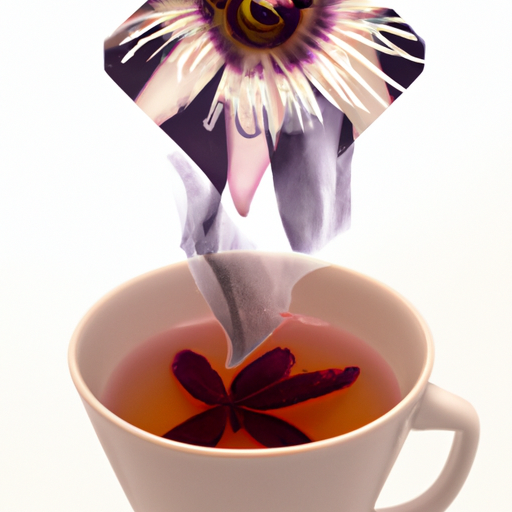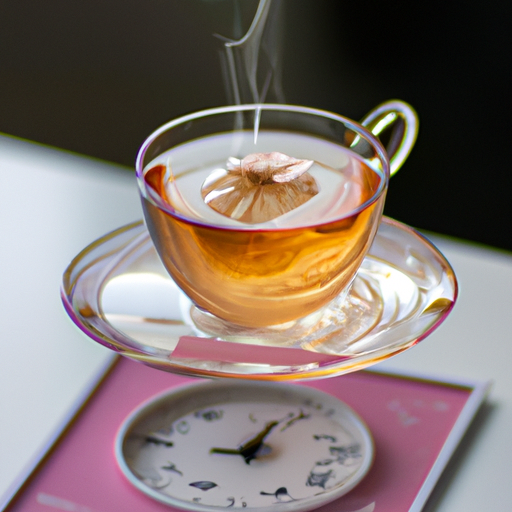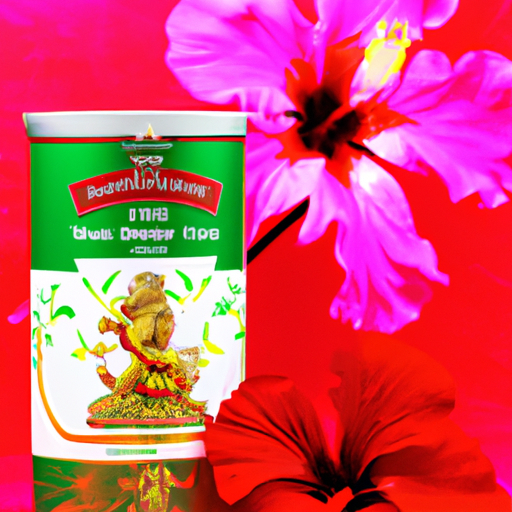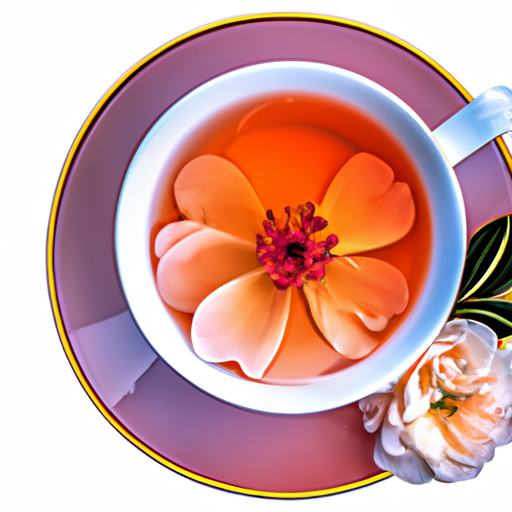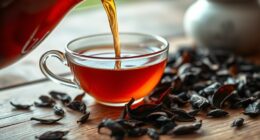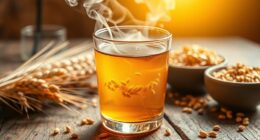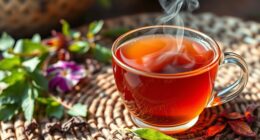Did you know that passion flower tea has been used for centuries to promote relaxation and relieve anxiety? It’s true! In fact, studies have shown that this herbal remedy can reduce symptoms of anxiety and improve sleep quality.
But how much passion flower tea should you actually be drinking to reap its benefits?
According to experts, the recommended dosage of passion flower tea is 1-2 cups per day. However, the amount of tea you should consume may vary depending on several factors, such as your body weight, sensitivity to the herb, and the severity of your symptoms. It’s important to find the right balance that works for you.
In this article, we will explore the factors that may influence the amount of passion flower tea you should drink, potential side effects of consuming too much, and how to personalize your consumption based on your own experience.
So, if you’re curious about how much passion flower tea is just right for you, keep reading!
Key Takeaways
- Passion flower tea promotes relaxation and relieves anxiety.
- The recommended dosage of passion flower tea is 1-2 cups per day, adjusted based on factors like body weight, sensitivity, and severity of symptoms.
- It is important to consult with a healthcare professional before making any changes to your herbal tea regimen.
- Personalizing passion flower tea consumption by experimenting with steeping times, temperatures, and additives can help find the right balance and benefits for you.
Understanding the Benefits of Passion Flower Tea
Imagine sipping on a warm cup of passion flower tea, allowing the soothing blend to calm your mind and fill you with a sense of tranquility. Passion flower tea is known for its numerous health benefits and has been used for centuries as a natural remedy for various ailments.
When trying passion flower tea for the first time, it’s recommended to start with a small amount. This allows your body to adjust to the effects of the tea and helps you gauge your tolerance. You can gradually increase the dosage as needed, keeping in mind that everyone’s reaction to passion flower tea may vary.
Passion flower tea is believed to promote relaxation, reduce anxiety, and improve sleep quality. It contains compounds that’ve been shown to have sedative effects on the central nervous system. Additionally, passion flower tea is rich in antioxidants, which help protect the body against oxidative stress and inflammation.
To experience the full benefits of passion flower tea, it’s important to find the right dosage for you. This will depend on various factors such as your body weight, overall health, and individual sensitivity. It’s always a good idea to consult with a healthcare professional before making any changes to your herbal tea regimen. With the right dosage, passion flower tea can be a wonderful addition to your daily routine, promoting both physical and mental well-being.
Recommended Dosage for Passion Flower Tea
When it comes to taking passion flower tea, it’s important to start with a small amount and gradually increase the dosage. This allows your body to adjust to the effects of the tea and helps to minimize any potential side effects. It’s also recommended to consult with a healthcare professional before starting any new herbal regimen to ensure it’s safe and appropriate for your specific needs.
Starting with a Small Amount
To get started, simply begin with a small amount of passion flower tea and let its calming effects slowly envelop you, as the saying goes, ‘Good things come in small packages.’
Passion flower tea is known for its numerous health benefits, including its ability to reduce anxiety, improve sleep quality, and promote relaxation. Starting with a small amount allows your body to acclimate to the tea and ensures that you don’t experience any unwanted side effects.
Here are a few things to keep in mind when starting with a small amount of passion flower tea:
- Begin with half a teaspoon of dried passion flower leaves.
- Steep the tea in hot water for 5-10 minutes.
- Sip the tea slowly and pay attention to how your body responds.
- Gradually increase the dosage over time, if desired, to experience greater benefits.
By starting small and gradually increasing the dosage, you can safely explore the wonderful effects of passion flower tea.
Gradually Increasing the Dosage
You should start with a small amount, but don’t be afraid to gradually increase the dosage to fully experience the powerful effects of passion flower tea. Starting with a small amount allows your body to adjust to the herb’s compounds and reduces the risk of any adverse reactions.
As you become more comfortable with the tea, gradually increasing the dosage can provide additional benefits. The gradual increase in dosage allows your body to adapt to the herb’s effects, ensuring a smoother transition. However, it’s important to note that everyone’s tolerance and sensitivity to passion flower tea may vary.
Consulting with a healthcare professional can provide valuable guidance on the appropriate dosage for your specific needs. By gradually increasing the dosage and seeking dosage consultation, you can optimize the benefits of passion flower tea while ensuring your safety and well-being.
Consulting with a Healthcare Professional
Seeking guidance from a healthcare professional ensures that you receive personalized advice on how to incorporate passion flower tea into your wellness routine. Consulting with a healthcare professional is especially important if you have any underlying health conditions or if you’re taking any medications. They can assess your individual situation and provide recommendations on the appropriate dosage and frequency of passion flower tea consumption.
Additionally, a healthcare professional can help identify any potential interactions between passion flower tea and your current medications. This personalized guidance can help you make informed decisions about how much passion flower tea to drink. It’s important to remember that everyone’s body is unique, and factors such as age, weight, and overall health may influence the amount of tea to drink.
Transitioning to the subsequent section, let’s explore the factors that may influence the amount of tea to drink.
Factors That May Influence the Amount of Tea to Drink
Consider incorporating factors such as personal preferences and individual tolerance levels, as they can greatly influence the ideal amount of passion flower tea to enjoy. When determining how much passion flower tea to drink, there are several factors to consider:
-
Sensitivity to herbal remedies:
- Some individuals may be more sensitive to the effects of passion flower tea due to their unique biochemistry. It’s important to start with a lower dose and gradually increase it if necessary.
- Consulting with a healthcare professional can help determine the appropriate dosage based on individual sensitivity.
-
Purpose of consumption:
- The amount of passion flower tea consumed may vary depending on the purpose. For mild relaxation, a small cup may be sufficient, while for more pronounced effects, a larger quantity may be necessary.
- It’s important to establish the intended goal and adjust the amount of tea accordingly.
Considering these factors can help ensure a safe and enjoyable experience with passion flower tea. However, it’s also crucial to be aware of potential risks and side effects. Consuming too much passion flower tea can lead to drowsiness, dizziness, and even confusion. Therefore, it’s important to be mindful of one’s personal tolerance levels and not exceed the recommended dosage.
In the next section, we’ll explore the potential side effects of consuming too much passion flower tea.
Potential Side Effects of Consuming Too Much Passion Flower Tea
Taking an excessive amount of passion flower tea can result in unwanted side effects and should be avoided. While passion flower tea is generally considered safe when consumed in moderation, consuming too much of it can potentially pose some health risks. Some individuals may experience symptoms such as dizziness, nausea, and vomiting if they consume an excessive amount of passion flower tea.
Additionally, long-term effects of consuming large quantities of passion flower tea are not well-studied, so it’s important to exercise caution. It’s always recommended to follow the instructions on the packaging or seek guidance from a healthcare professional when consuming passion flower tea.
It’s important to note that everyone’s tolerance and sensitivity to passion flower tea may vary, so it’s crucial to listen to your body and adjust the amount based on personal experience. Gradually increasing the amount of tea consumed can help determine your individual tolerance and prevent any potential side effects.
By being mindful and responsible in your consumption of passion flower tea, you can enjoy its potential benefits without any adverse effects.
Transitioning into the next section, let’s explore the process of adjusting the amount based on personal experience.
Adjusting the Amount Based on Personal Experience
By gradually increasing my intake, I was able to gauge my tolerance and fine-tune the amount of passion flower tea I consume based on personal experience. This approach allowed me to find a dosage that was more tailored to my needs and potentially more beneficial.
Starting with a small amount and gradually increasing the dosage is a smart way to approach any new herbal tea or supplement. It gives your body time to adjust and helps you avoid any potential side effects that may arise from consuming too much too soon.
Here are four important points to keep in mind when adjusting the amount of passion flower tea you consume:
-
Start with a small amount: Begin by brewing a cup of passion flower tea using a small amount of dried passion flower. This will allow you to assess your initial tolerance and see how your body responds to the tea.
-
Gradually increase the dosage: If you tolerate the initial amount well, you can gradually increase the amount of dried passion flower in your tea. This will help you find the optimal dosage that provides the desired effects without any negative side effects.
-
Observe your body’s response: Pay attention to how your body responds to different dosages. Take note of any changes in mood, sleep patterns, or overall well-being. This will help you determine the dosage that works best for you.
-
Consult a healthcare professional: If you have any concerns or questions about adjusting the amount of passion flower tea you consume, it’s always a good idea to consult with a healthcare professional. They can provide personalized advice and guidance based on your specific needs and health conditions.
By adjusting the amount of passion flower tea I consume based on personal experience, I was able to find a dosage that worked well for me.
Now, let’s explore the next section about brewing methods and tea concentration.
Brewing Methods and Tea Concentration
As you experiment with different brewing methods and adjust the concentration of your brew, you may uncover the perfect balance of flavors and strengths that truly enhance your passion flower tea experience. The brewing temperature and steeping time play crucial roles in determining the taste and potency of your brew.
To ensure the best results, start by heating water to around 200°F (93°C). This temperature allows the flavors and beneficial compounds in the passion flower to infuse into the water without becoming overly bitter. Next, add one to two teaspoons of dried passion flower leaves to a cup of hot water. Let the tea steep for about 5 to 10 minutes to extract the full range of flavors and therapeutic properties. You can adjust the steeping time based on your personal preference for a stronger or milder brew.
Once your tea is ready, take a moment to savor the delicate floral aroma and taste. It’s important to note that passion flower tea is best enjoyed in moderation. While it offers numerous health benefits, excessive consumption may lead to side effects. So, it’s wise to limit your intake and listen to your body’s signals.
Now, let’s explore the timing and frequency of drinking passion flower tea to maximize its potential benefits and overall enjoyment.
Timing and Frequency of Drinking Passion Flower Tea
When it comes to timing and frequency of drinking passion flower tea, I’ve found that drinking it before bedtime has helped me achieve better sleep. The calming properties of passion flower tea can help relax the mind and body, making it easier to fall asleep and stay asleep throughout the night.
Additionally, I’ve also found that drinking passion flower tea throughout the day can help promote a sense of relaxation and reduce stress levels.
Before Bedtime for Better Sleep
For a more restful night’s sleep, try drinking passion flower tea before bedtime. Incorporating passion flower tea into your bedtime routine can help promote relaxation and improve the quality of your sleep.
Passion flower is a natural sleep aid that’s been used for centuries to calm the mind and body. It contains compounds that have a sedative effect, helping to ease anxiety and promote a sense of calmness. Research suggests that passion flower tea can improve sleep quality and reduce the time it takes to fall asleep.
By enjoying a warm cup of passion flower tea before bed, you can create a soothing ritual that signals to your body that it’s time to wind down and prepare for sleep.
Throughout the day, passion flower tea can also be enjoyed for relaxation, providing a natural way to de-stress and promote overall well-being.
Transitioning into the subsequent section, passion flower tea can be a beneficial addition to your daily routine.
Throughout the Day for Relaxation
Incorporating a warm cup of this soothing herbal infusion into my daily routine can create a calming ritual that promotes relaxation and overall well-being. Passion flower tea isn’t only beneficial before bedtime, but it can also be enjoyed throughout the day for its relaxation properties. Here are three relaxation techniques that can be enhanced by sipping on this herbal remedy:
-
Deep breathing exercises: Take slow, deep breaths while savoring each sip of passion flower tea, allowing your body to fully relax.
-
Mindfulness meditation: Pairing your meditation practice with a cup of passion flower tea can help you achieve a deeper state of relaxation and focus.
-
Yoga practice: Sip on passion flower tea before or during your yoga session to enhance the calming effects and promote a greater sense of tranquility.
By incorporating these relaxation techniques into your day and listening to your body’s response to the tea, you can further enhance its benefits.
Listening to Your Body’s Response to the Tea
Pay attention to how your body reacts to passion flower tea – it could be a game-changer for your well-being! When it comes to relaxation, it’s important to listen to your body’s signals and adjust accordingly. By using effective listening techniques, you can truly understand how passion flower tea affects you personally.
To help you navigate this process, here is a table outlining some common body signals and their potential meanings when consuming passion flower tea:
| Body Signal | Potential Meaning |
|---|---|
| Feeling calm and relaxed | Passion flower tea is having a positive effect on your well-being. |
| Slight drowsiness | The tea may be inducing a sense of tranquility and aiding in sleep. |
| Mild stomach discomfort | Your body might be sensitive to the tea, so consider adjusting the dosage or trying a different brand. |
| No noticeable change | It’s possible that passion flower tea may not have a significant impact on you, and that’s okay. Everyone reacts differently to herbal remedies. |
| Increased alertness | This could be a sign that passion flower tea is not the right fit for you. Consider trying other herbal remedies for relaxation. |
By paying attention to these signals, you can make informed decisions about incorporating passion flower tea into your wellness routine. In the next section, we will explore how combining passion flower tea with other herbal remedies can enhance its benefits without overwhelming your system.
Combining Passion Flower Tea with Other Herbal Remedies
After listening to my body’s response to passion flower tea and experiencing its calming effects, I became intrigued by the idea of combining this herbal remedy with other natural remedies to amplify its benefits.
Passion flower tea, known for its anxiolytic properties, can be even more effective when paired with certain herbal remedies that target specific health concerns.
When combining passion flower tea with other herbal remedies, it’s important to consider potential interactions and synergies. For example, pairing passion flower tea with chamomile tea can enhance its calming effects and promote better sleep. Both herbs have mild sedative properties that work synergistically to relax the mind and body.
Additionally, combining passion flower tea with valerian root can further enhance its sedative effects, making it an excellent choice for individuals struggling with sleep disorders.
It’s crucial to research and consult with a healthcare professional before combining herbal remedies, as certain combinations may have unintended consequences or interactions with medications. However, when done safely and appropriately, combining passion flower tea with other herbal remedies can create powerful and holistic solutions for various health concerns.
Transitioning into the next section about personalizing passion flower tea consumption, it’s essential to understand how to tailor the tea to individual needs and preferences.
Personalizing Your Passion Flower Tea Consumption
To customize my passion flower tea experience, I can experiment with different steeping times, temperatures, and additives to create the perfect cup tailored to my individual preferences. When starting with a small amount of passion flower tea, I can gradually adjust the amount based on my personal experience and desired effects.
Steeping time is an important factor to consider when preparing passion flower tea. Generally, a steeping time of 5-10 minutes is recommended to extract the beneficial compounds from the flowers. However, some individuals may prefer a shorter or longer steeping time to achieve their desired taste and potency. It’s all about finding what works best for me.
Temperature is another aspect that can be personalized when making passion flower tea. The ideal temperature for steeping passion flower tea is around 200°F (93°C). However, I can experiment with slightly higher or lower temperatures to see how it affects the flavor and potency of the tea.
Additives can also be incorporated to enhance the flavor or add additional health benefits. For example, I can add a slice of lemon or a teaspoon of honey to sweeten the tea and give it a refreshing twist. Additionally, I can combine passion flower tea with other herbal remedies such as chamomile or lavender to create a unique blend that suits my preferences.
By taking the time to personalize my passion flower tea consumption, I can truly enjoy a cup that is perfectly suited to my individual needs and tastes. Starting with a small amount and adjusting based on my personal experience allows me to find the ideal balance and reap the maximum benefits of this wonderful herbal infusion.
Frequently Asked Questions
Can passion flower tea help with anxiety and stress relief?
Passion flower tea is a powerful elixir for anxiety and stress relief. Sipping on this soothing brew can calm the storm within, like a gentle breeze on a turbulent sea. The benefits of passion flower tea are well-documented, with studies showing its ability to reduce anxiety and promote relaxation.
To prepare this herbal remedy, simply steep 1-2 teaspoons of dried passion flower in hot water for 10-15 minutes. Soothe your mind and body with the magic of passion flower tea.
Is it safe to consume passion flower tea during pregnancy?
Passion flower tea can be a safe option for breastfeeding mothers, but it’s important to consult with a healthcare professional before consuming it during pregnancy. While there’s limited research on the effects of passion flower tea on pregnancy, some studies suggest it may cause uterine contractions and potentially lead to miscarriage. It’s also worth noting that passion flower tea may have mild side effects like drowsiness and dizziness. It’s always best to err on the side of caution and seek medical advice before consuming any herbal tea during pregnancy.
How long does it take for passion flower tea to start showing its effects?
Passion flower tea typically starts showing its effects within 30 minutes to an hour after consumption. To brew passion flower tea properly, start by boiling water and pouring it over 1-2 teaspoons of dried passion flower. Let it steep for about 10-15 minutes before straining. To enhance the flavor, you can add honey or lemon juice. Remember to consult with a healthcare professional before consuming passion flower tea, especially during pregnancy.
Can passion flower tea be consumed by children?
Passion flower tea can be consumed by children, but it’s important to consider the dosage. The benefits of passion flower tea for children include its calming and soothing effects, which can help with anxiety and promote better sleep. However, it’s recommended to consult with a healthcare professional to determine the appropriate dosage for children, as it may vary depending on their age and weight. Safety should always be a priority when giving herbal remedies to children.
Are there any known drug interactions with passion flower tea?
Passion flower tea has been touted for its potential benefits on sleep quality. However, it’s important to consider potential side effects and drug interactions. While there’s limited evidence supporting its effectiveness, some studies suggest that passion flower tea may improve sleep quality due to its calming properties.
However, it’s crucial to consult with a healthcare professional before consuming passion flower tea, especially if you’re taking medications, as it may interact with certain drugs.
Conclusion
In conclusion, passion flower tea is an absolute game-changer! It’s like a magic elixir that brings tranquility and relaxation to a whole new level.
With its numerous benefits and minimal side effects, it’s hard to resist the allure of this incredible herbal remedy. And the best part? You can customize your dosage based on your personal needs and preferences.
So go ahead, take a sip of this heavenly brew and let the passion flower tea revolution begin!

